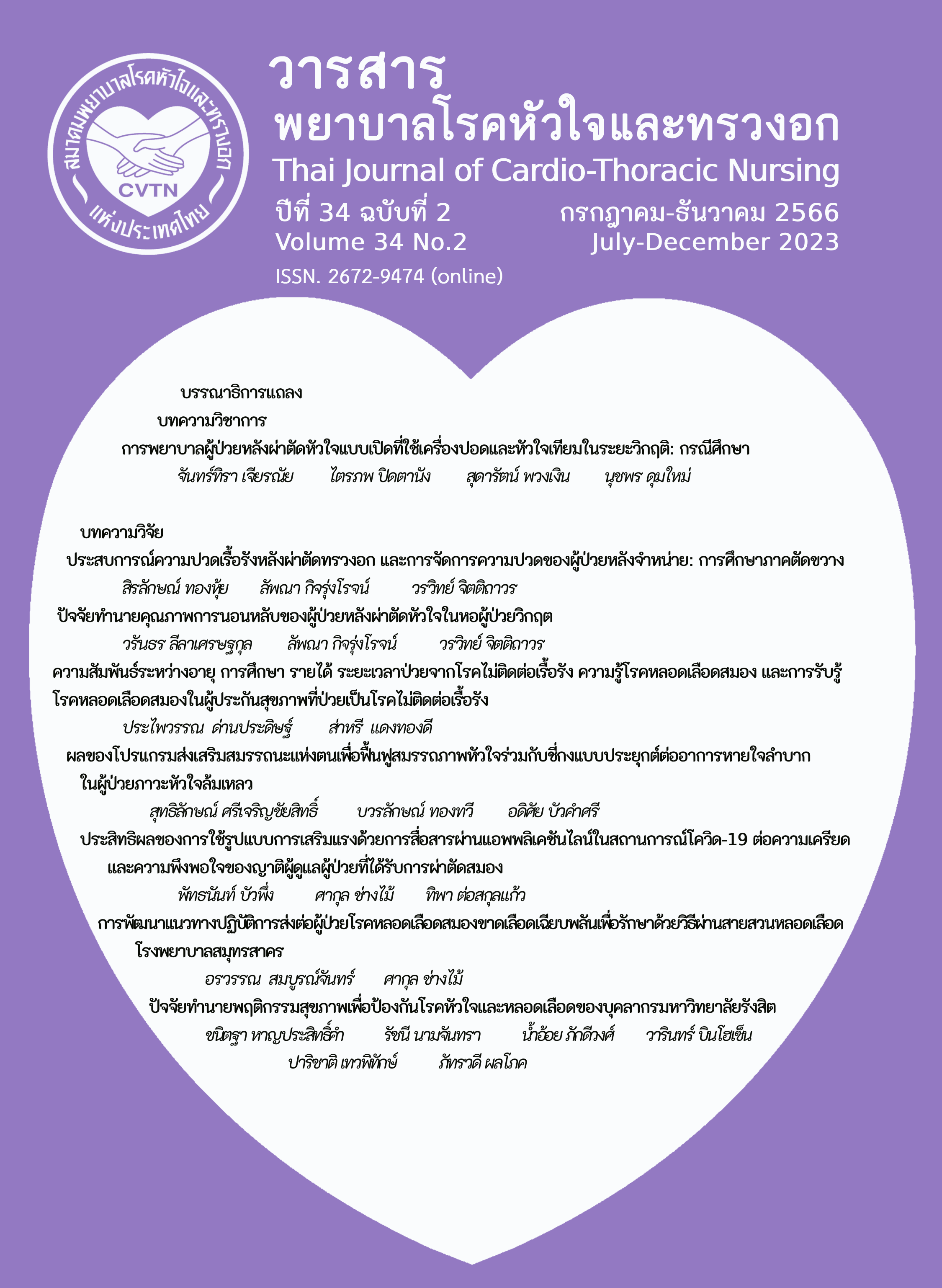Chronic post thoracotomy pain experience, and pain management among patients after discharge: a cross-sectional study
Keywords:
chronic post-thoracotomy pain, pain managementAbstract
This cross-sectional descriptive study aimed to investigate chronic post-thoracotomy pain (CPTP) and pain management among patients having had thoracotomy after discharge. The 60 samples were purposively selected from patients with open thoracotomy who had CPTP for at least 3 months after being discharged from the Songklanagarind Hospital from June 2020 to May 2021. Data were collected using interviews with a set of questionnaires including 1) the Demographic and Health-related Data Questionnaire, 2) the CPTP Experience Questionnaire, and 3) the Chronic Pain Management Methods Questionnaire. Data were analyzed using descriptive statistics and content analysis.
The results were as follows: the location of chronic pain was at an incision wound site. Pain characteristics were commonly described as sharp (71.7%), burning or electrical shock (25.0%), and tingling (23.3%). The pain intensity was at a mild level (Mdn = 3.0, IQR = 2.0). Most patients had no interference with daily life. Most of the patients managed their CPTP by using non-pharmacological methods (97.0%). The commonly used pain management methods included 1) caring for surgical wounds by reducing or not using muscle force at the surgical wound site, 2) using distraction, receiving information and encouragement, and 3) adjusting thought and performing religious activities. They gave the reasons that they relax the body and mind and relieve pain. Moreover, most patients evaluated the effectiveness of these pain management methods at high to moderate levels.
The results of this study suggest that nurses should provide knowledge about CPTP, pharmacological and non-pharmacological pain management for pain relief to patients prior to hospital discharge.
References
The Society of Thoracic Surgeons of Thailand. (2022). Heart and thoracic surgery statistics in Thailand 2019-2021. [document on the Internet]. Bangkok: The society; 2022 [Update 2022 Feb 10; cited 2022 Feb 25]. Available from: https://kyl.psu.th/XFPvH
Marzorati C, Mazzocco K, Monzani D, Pavan F, Casiraghi M, Spaggiari L, et al. One-year quality of life trends in early-stage lung cancer patients after lobectomy. Front Psychol. 2020 Dec 10;11:534428. doi: 10.3389/fpsyg.2020.534428. PMID: 33362618; PMCID: PMC7758417.
Bayman EO, Parekh KR, Keech J, Selte A, Brennan TJ. A prospective study of chronic pain after thoracic surgery. Anesthesiol. 2017;126(5):938-51.
Hetmann F, Kongsgaard UE, Sandvik L, Schou-Bredal I. Post-thoracotomy pain syndrome and sensory disturbances following thoracotomy at 6- and 12-month follow-ups. J Pain Res. 2017;10: 663-8.
Peng J, Wang Z, Ma L, Ma W, Liu G, Zhang H, et al. Incidence and influencing factors of chronic post-thoracotomy pain in lung tumor patients. J Health Eng. 2022 Feb 24;2022: 7584481. doi: 10.1155/2022/7584481.
Fiorelli S, Cioffi L, Menna C, Ibrahim M, De Blasi RA, Rendina EA, et al. Chronic pain after lung resection: risk factors, neuropathic pain, and quality of life. J Pain Symptom Manage. 2020;60(2):326-35.
Kar P, Sudheshna KD, Padmaja D, Pathy A, Gopinath R. Chronic pain following thoracotomy for lung surgeries: its risk factors, prevalence, and impact on quality of life-A retrospective study. Indian J Anaesth. 2019;63(5):368-74.
Doan LV, Augustus J, Androphy R, Schechter D, Gharibo C. Mitigating the impact of acute and chronic post-thoracotomy pain. J Cardiothorac Vasc Anesth. 2014;28(4):1048-56.
Schug SA, Lavand'homme P, Barke A, Korwisi B, Rief W, Treede RD. The IASP classification of chronic pain for ICD-11: chronic postsurgical or posttraumatic pain. Pain. 2019;160(1):45-52.
Grosen K, Laue Petersen G, Pfeiffer-Jensen M, Hoejsgaard A, Pilegaard HK. Persistent post-surgical pain following anterior thoracotomy for lung cancer: a cross-sectional study of prevalence, characteristics and interference with functioning. Eur J Cardiothorac Surg. 2013;43(1):95-103.
Ee Chin JW, Valchanov K. Pharmacological management of post-thoracotomy pain. Open Med J. 2016;(3):255-64.
Yanik F, Karamustafaoglu YA. The management of chronic post-thoracotomy pain syndrome. EC Pulmonol Respir Med. 2017;5(5):211-2.
Arends S, Bohmer AB, Poels M, Schieren M, Koryllos A, Wappler F, Joppich R. Post-thoracotomy pain syndrome: seldom severe, often neuropathic, treated unspecific, and insufficient. Pain Rep. 2020;5(2): e810.
Puttakun N. Chronic Pain Experience, Pain management and quality of life of persons with spinal cord injury. [Master Thesis of Nursing Science]. Songkhla: Prince of Songkla University; 2014. (in Thai).
Ruangrit T, Sindhvananda W. Pain perspectives in Thai chronic pain patients. Thai J Anesthesiol. 2018;44(3):127-35. (in Thai).
Faculty of Medicine. Department of Surgery. CVT Surgery. Thoracic surgery statistics in Songklanagarind Hospital 2016-2020. Songkhla: CVT Surgery; 2020.
Dodd M, Janson S, Facione N, Faucett J, Froelicher ES, Humphreys J, Lee K, Miaskowski C, Puntillo K, Rankin S, Taylor D. Advancing the science of symptom management. J Adv Nurs. 2001;33(5):668-76.
Niruttisat S. Pain: an overview. In: Niruttisat S. Essential Knowledge in Pain Management. Bangkok: Amarin Corporations Public; 2016. p. 2-11.
Kittisomprayoonkul W. Revised Thai short-form McGill Pain Questionnaire. Chula Med J. 2005;49(3):143-55. (in Thai).
Chaudakshetrin P. Validation of the Thai version of Brief Pain Inventory (BPI-T) in cancer patients. J Med Assoc Thai. 2009;92(1):34-40.
Leaungsomnapa Y, Ngamkham S. Attention to pain. J Prapokklao Hosp Clin Med Educat Center. 2013;30(2):83-93. (in Thai).
Sorarree N. Principle of nursing care for acute and chronic pain. In: Nilmanat K, Wetprasit R. editors. Nursing care for adult and elderly patients 1. Songkhla: Faculty of Nursing. Prince of Songkla University; 2016. p. 67-89. (in Thai).
Densuntikul J, Kanitapiluk J, Chaiwannawat T. The role of anesthetist nurses on pain management in postoperative patients relating to cultural beliefs. J NAT North. 2020;26(1):76-89. (in Thai).
Downloads
Published
How to Cite
Issue
Section
License
Copyright (c) 2024 Thai Journal of Cardio-Thoracic Nursing

This work is licensed under a Creative Commons Attribution-NonCommercial-NoDerivatives 4.0 International License.
บทความนี้ยังไม่เคยตีพิมพ์หรืออยู่ในระหว่างส่งไปตีพิมพ์ในวารสารอื่น ๆ มาก่อน และกองบรรณาธิการขอสงวนสิทธิ์ในการตรวจทาน และแก้ไขต้นฉบับตามเกณฑ์ของวารสาร ในกรณีที่เรื่องของท่านได้ได้รับการตีพิมพ์ในวารสารฉบับนี้ถือว่าเป็น ลิขสิทธิ์ของวารสารพยาบาลโรคหัวใจและทรวงอก






